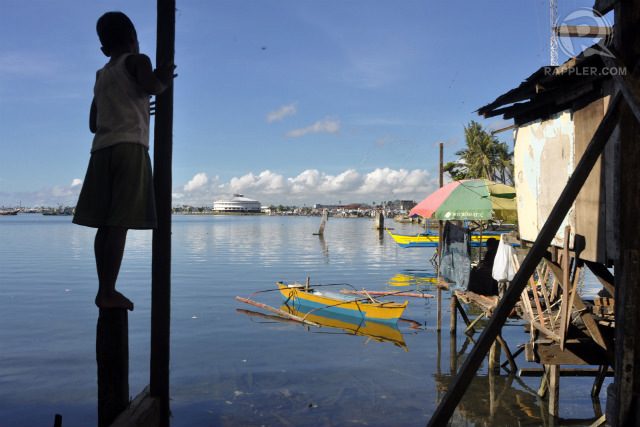SUMMARY
This is AI generated summarization, which may have errors. For context, always refer to the full article.

MANILA, Philippines – Rehabilitation that couldn’t begin until 3 days before the State of the Nation Address (SONA). More than 14,500 survivors still living in tents. A headless command center after Super Typhoon Yolanda (Haiyan) left thousands dead.
President Benigno Aquino III omitted these details from his SONA on Monday, July 28, as he painted Yolanda-hit areas in a rosy state.
In his SONA, Aquino trumpeted government efforts after Yolanda by citing details such as the following:
-
He has signed the local rehabilitation plans for Cebu, Iloilo, Samar, Eastern Samar, Leyte, and Tacloban City.
-
The government has created at least 221,897 jobs after the government provided boats, fishing equipment, seeds, livestock, and cash-for-work schemes for Yolanda survivors.
-
When Yolanda struck in November 2013, the government “wasted no time in responding,” and quickly distributed food packs, cleared debris, and restored electricity to “all municipalities affected by the calamity” by Christmas Day of 2013.
Rehab plan days before SONA
It is true, for one, that Aquino signed the local rehabilitation plans for the 6 local government units he mentioned during his SONA.
What Aquino didn’t say is that he approved these plans only on Friday, July 25, or 3 days before his annual speech on Monday.
The Office of the Presidential Assistant for Rehabilitation and Recovery, headed by Rehabilitation Secretary Panfilo Lacson, submitted these plans to Aquino on July 1.
This was the first set of local Yolanda-related rehabilitation plans submitted to Aquino.
Rehabilitation officially begins only when the President approves these documents. Once approved, “it means that the Department of Budget and Management can now release the funds to the implementing agencies,” and rehabilitation can begin any time, Lacson said.
Lacson earlier said rehabilitation could begin in June.
In any case, evaluating rehabilitation efforts, an expert told Rappler the Philippines’ system is “designed to fail for massive disasters.” Lacson’s lack of authority as a “CEO without a budget” doesn’t help. (READ: 6 months after Yolanda: ‘We are failing’ and ‘Uncooperative’ officials derailing Yolanda rehab?)
14,500 still living in tents
In Aquino’s SONA, it may also be true that the government has “created at least 221,897 jobs” for Yolanda survivors.
The President, however, failed to mention that while given employment, thousands of Yolanda survivors remain homeless.
In an e-mail to Rappler on Wednesday, July 30, Department of Social Welfare and Development Director Thelsa Biolena said about 3,096 families of Yolanda survivors still live in tents in Region VIII or Eastern Visayas alone.
This is equivalent to at least 14,551 individuals.
Now they’re facing new calamities. Up to 2,600 of these homeless survivors, in fact, had to evacuate when Typhoon Glenda (Rammasun) struck the Philippines nearly two weeks before the SONA.
Explaining the homelessness, the government had said it lacks land for resettlement, but is on its way to solve this problem.
Earlier, the government started building bunkhouses for homeless survivors, but encountered problems with substandard shelters.
On electricity, while Aquino claimed power was restored in “all municipalities affected by the calamity” by Christmas Day of 2013, reports back then said otherwise. Energy Secretary Jericho Petilla, in fact, said he will resign after 3 towns remained “without power” on Christmas Day.
What government overlooked
There were also problems with the government’s immediate response when Yolanda hit land.
Defense Secretary Voltaire Gazmin and Interior Secretary Mar Roxas flew to Tacloban City to oversee efforts to respond to Yolanda.
Gazmin and Roxas serve as the country’s top two disaster officials – Gazmin as chair of the National Disaster Risk Reduction and Management Council, and Roxas as its vice chair.
The two secretaries, however, lost contact with Manila when Yolanda toppled cell sites in the Visayas. Roxas later admitted “overlooking” the need to bring satellite phones.
In any case, Aquino said in his SONA, “on that same day, we were also able to set up a communications hub to hasten the flow of information.”
Aquino added that within 24 hours after the storm, “three C130s were able to bring aid.”
He didn’t say that Gazmin realized something too late 3 days after Yolanda made landfall in Guiuan, Eastern Samar: That he can tap Guiuan’s airport and seaport to speed up aid for Yolanda survivors.
No ground commander
Aquino also omitted two basic problems that hounded worst-hit Tacloban: politics and the lack of command.
The problem with politics, for one, involved the national government’s alleged refusal to help Tacloban unless Tacloban Mayor Alfred Romualdez signed an ordinance to allow this.
Romualdez recounted that when he questioned Roxas about the need for an ordinance, Roxas “answered me and told me, ‘You have to remember, we have to be careful. You are a Romualdez and the President is an Aquino.'”
Romualdez comes from the clan of Imelda Romualdez Marcos, wife of the late dictator Ferdinand Marcos who jailed Aquino’s father.
Roxas, for his part, said Romualdez took his words out of context.
The other basic problem, however, was the lack of a ground commander shortly after the disaster. Roxas said there was “no such title,” and that the government employed a “consultative process.”
Speaking to Rappler back then, an aid worker complained that they “have so many bosses but nobody makes decisions.”
In his SONA, Aquino thanked all the officials involved and saw nothing wrong. – Rappler.com
Add a comment
How does this make you feel?
There are no comments yet. Add your comment to start the conversation.